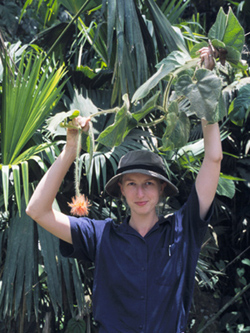The Gurania Pages
Page 4
Amanda
K. Neill
Although Gurania and Psiguria
certainly are conspicuous plants, there are not many recorded human uses
for these genera. Those uses are often medicinal, as most fruits
have an unpleasant or bitter taste. However, to many other species,
these are very important food sources. Many Heliconius butterflies
and hummingbird species rely on the pollen or nectar produced in the flowers,
and these interactions have been the focus of past studies. The dispersal
of fruits and seeds is a greater mystery. Some species' fruits are
distributed by bats in the genus Phyllostomus. Studies have
shown that bats are attracted by the smell of the ripe fruit, and also
echolocate the clusters of fruits conveniently hanging far below tree branches.
This does not explain the dispersal of species with showy yellow and orange
fruits, and it is hypothesized that birds are the agents of dispersal in
those cases. Possible culprits are Trogons, Bellbirds, and perhaps
Quetzals. Numerous invertebrates also prey on Gurania and
Psiguria,
including Blepharoneura flies (Tephritidae) (see
Marty Condon's "Flies Without Names" page).
| Over 100 species names have
been published in the genus Gurania in the last 150 years.
There are no keys to identification that cover the entire range of the
genus. Staminate herbarium specimens far outnumber specimens of the
more difficult-to-reach pistillate inflorescences, and only rare specimens
include both sexes. As already stated, the leaf shape on one plant
can vary widely, enough to warrant differing species determinations on
duplicate specimens of a single collection. There is a definite need
for monographic studies of both Gurania and Psiguria, to
allow identification and cataloging in the many floristic efforts underway
in the neotropics, and to clarify coevolutionary relationships in associated
organisms.
My fascination with Gurania
and Psiguria is based in these diverse and charismatic ecological
interactions, and in the morphological variations by which these genera
have adapted to these interactions. I am using microscopic and macroscopic
morphological characters, geographic distributions, molecular sequencing,
and field observations, combined with ecological data, to produce a monograph
of Gurania at the New York Botanical Garden. |
 |
Page
1
Page
2
Page
3
Selected Links
Amanda
Neill's homepage
Larry
Gilbert's Laboratory at the University of Texas at Austin
Marty
Condon at Cornell College, Iowa
The
Cucurbit Network
The
New York Botanical Garden
Selected References
Condon, M. 1984. Reproductive biology, demography,
and natural history of neotropical vines Gurania and Psiguria
(Guraniinae,
Cucurbitaceae): a study
of the adaptive significance of size related sex change. Ph.D. dissertation,
University of Texas, Austin.
Condon, M. and L.E. Gilbert. 1988. Sex expression
of Gurania and Psiguria (Cucurbitaceae): Neotropical vines
that change sex. Amer.
J. Bot. 75:875-884.
Condon, M. and L.E. Gilbert. 1990. Reproductive
biology and natural history of the neotropical vines Gurania and
Psiguria.
In Biology
and Utilization of the
Cucurbitaceae (D.M. Bates, R.W. Robinson, and C. Jeffrey, eds.). Cornell
University Press, Ithaca, NY.
Feisinger, P. and R.K. Colwell. 1978. Commmunity
organization among neotropical nectar feeding birds. Amer. Zool. 18:779-795.
Gilbert, L.E. 1972. Pollen feeding and reproductive
biology of Heliconius butterflies. Proc. Natl. Acad. USA 69:1403-1407.
Photo by John Janovec.
Last updated 24 May 2001 by
Amanda Neill.
